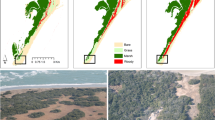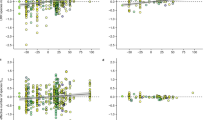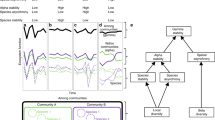Abstract
The end of the African Humid Period between 6,000 and 4,000 years ago was associated with large changes in precipitation and vegetation cover. Sediment records from Lake Yoa, Chad, show a gradual decline in precipitation and fluctuation in vegetation over this interval, and have been suggested to demonstrate a weak interaction between climate and vegetation1,2,3. However, interpretation of these data has neglected the potential effects of plant diversity on the stability of the climate–vegetation system. Here we use a conceptual model that represents plant diversity in terms of moisture requirement. Some of the plant types simulated are sensitive to changes in precipitation, which alone would lead to an unstable system with the possibility of abrupt changes. Other plants are more resilient, resulting in a stable system that changes gradually. We demonstrate that plant diversity tends to attenuate the instability of the interaction between climate and sensitive plant types, whereas it reduces the stability of the interaction between climate and less-sensitive plant types. Hence, despite large sensitivities of individual plant types to precipitation, a gradual decline in precipitation and shift in mean vegetation cover can occur. However, we suggest that the system could become unstable if some plant types were removed or introduced, leading to an abrupt regime shift.
This is a preview of subscription content, access via your institution
Access options
Subscribe to this journal
Receive 12 print issues and online access
$259.00 per year
only $21.58 per issue
Buy this article
- Purchase on Springer Link
- Instant access to full article PDF
Prices may be subject to local taxes which are calculated during checkout



Similar content being viewed by others
References
Kröpelin, S. et al. Climate-driven ecosystem succession in the Sahara: The past 6000 years. Science 30, 765–768 (2008).
Francus, P. et al. Varved sediments of Lake Yoa (Ounianga Kebir, Chad) reveal progressive drying of the Sahara during the last 6100 years. Sedimentology 60, 911–934 (2013).
Lézine, A-M., Hély, C., Grenier, C., Braconnot, P. & Krinner, G. Sahara and Sahel vulnerability to climate changes, lessons from Holocene hydrological data. Quat. Sci. Rev. 30, 3001–3012 (2011).
Brovkin, V., Claussen, M., Petoukhov, V. & Ganopolski, A. On the stability of the atmosphere-vegetation system in the Sahara/Sahel region. J. Geophys. Res. 103, 31613–31624 (1998).
DeMenocal, P. B. et al. Abrupt onset and termination of the African Humid Period: Rapid climate response to gradual insolation forcing. Quat. Sci. Rev. 19, 347–361 (2000).
Scheffer, M., Carpenter, S., Foley, J. A., Folke, C. & Walker, B. Catastrophic shifts in ecosystems. Nature 413, 591–596 (2001).
Liu, Z., Wang, Y., Gallimore, R., Notaro, M. & Prentice, I. C. On the cause of abrupt vegetation collapse in North Africa during the Holocene: Climate variability vs. vegetation feedback. Geophys. Res. Lett. 33, L22709 (2006).
Brovkin, V. & Claussen, M. Comment on climate-driven ecosystem succession in the Sahara: The past 6000 Years. Science 322, 1326 (2008).
Kröpelin, S., Verschuren, D. & Lézine, A-M. Response to comment on climate-driven ecosystem succession in the Sahara: The past 6000 Years. Science 322, 1326 (2008).
Timm, O., Köhler, P., Timmermann, A. & Menviel, L. Mechanisms for the Onset of the African Humid Period and Sahara Greening 14.5–11 Ka BP. J. Clim. 23, 2612–633 (2010).
Claussen, M. Modelling biogeophysical feedback in the African and Indian Monsoon region. Clim. Dynam. 13, 247–257 (1997).
Claussen, M. & Gayler, V. The greening of Sahara during the mid-Holocene: Results of an interactive atmosphere—biome model. Glob. Ecol. Biogeogr. Lett. 6, 369–377 (1997).
Liu, Z. et al. Simulating the transient evolution and aabrupt change of Northern Africa Atmosphere-Ocean-Terrestrial Ecosystem in the Holocene. Quat. Sci. Rev. 26, 1818–1837 (2007).
Williams, J. W., Blois, J. L. & Shuman, B. N. Extrinsic and intrinsic forcing of abrupt ecological change: case studies from the late Quaternary. J. Ecol. 99, 664–677 (2011).
Watrin, J., Lézine, A. M. & Hély, C. Plant migration and plant communities at the time of the green Sahara. C.R. Geosci. 341, 656–670 (2009).
Bathiany, S., Claussen, M. & Fraedrich, K. Implications of climate variability for the detection of multiple equilibria and for rapid transitions in the atmosphere-vegetation system. Clim. Dynam. 38, 1775–1790 (2012).
Kleidon, A., Fraedrich, K. & Low, C. Multiple steady-states in the terrestrial atmosphere-biosphere system: A result of discrete vegetation classification? Biogeosciences 4, 707–714 (2007).
van Nes, E. H. & Scheffer, M. Implications of spatial heterogeneity for catastrophic regime shifts in ecosystems. Ecology 86, 1797–1807 (2005).
Bathiany, S., Claussen, M. & Fraedrich, K. Detecting hotspots of atmosphere-vegetation interaction via slowing down—part 1: A stochastic approach. Earth Syst. Dynam. 4, 63–78 (2013).
Long, S. P., Ainsworth, E. A., Leakey, A. D. B., Nösberger, J. & Ort, D. R. Food for thought: Lower-than-expected crop yield stimulation with rising CO2 concentrations. Science 312, 1918–1921 (2006).
Zeng, N. & Neelin, J. D. The role of vegetation-climate interaction and interannual variability in shaping the African savanna. J. Clim. 13, 2665–2670 (2000).
Zeng, N., Hales, K. & Neelin, J. D. Nonlinear dynamics in a coupled vegetation-atmosphere system and implications for desert-forest gradient. J. Clim. 15, 3474–3487 (2002).
Wang, G. L. A conceptual modeling study on biosphere-atmosphere interactions and its implications for physically based climate modelling. J. Clim. 17, 2572–2583 (2004).
Whittaker, R. H. Communities and Ecosystems 2nd edn (Macmillan, 1975).
Hanski, I. Metapopulation dynamics. Nature 396, 41–49 (1998).
Acknowledgements
The authors thank J. Pongratz, C. Reick and T. Raddatz, Max Planck Institute for Meteorology, for discussions.
Author information
Authors and Affiliations
Contributions
M.C. designed the research and carried out the simulations. All authors discussed the results and contributed to the manuscript.
Corresponding author
Ethics declarations
Competing interests
The authors declare no competing financial interests.
Supplementary information
Supplementary Information
Supplementary Information (PDF 1614 kb)
Rights and permissions
About this article
Cite this article
Claussen, M., Bathiany, S., Brovkin, V. et al. Simulated climate–vegetation interaction in semi-arid regions affected by plant diversity. Nature Geosci 6, 954–958 (2013). https://doi.org/10.1038/ngeo1962
Received:
Accepted:
Published:
Issue Date:
DOI: https://doi.org/10.1038/ngeo1962
This article is cited by
-
Remotely sensing potential climate change tipping points across scales
Nature Communications (2024)
-
Correlation analysis of cavitation-induced pressure pulsation and vibration in a bulb turbine
Journal of Hydrodynamics (2024)
-
Effects of Dynamic Vegetation on Global Climate Simulation Using the NCEP GFS and SSiB4/TRIFFID
Journal of Meteorological Research (2021)
-
Past abrupt changes, tipping points and cascading impacts in the Earth system
Nature Geoscience (2021)
-
Self-amplified Amazon forest loss due to vegetation-atmosphere feedbacks
Nature Communications (2017)



